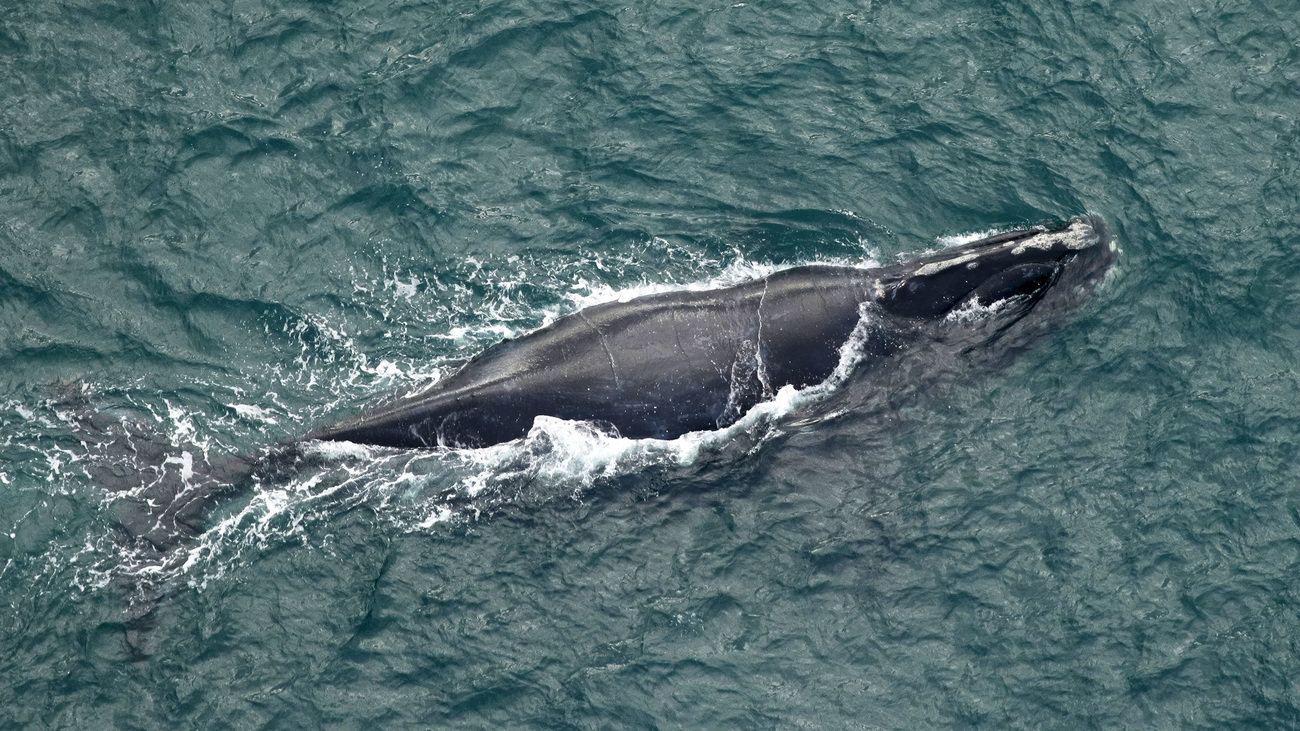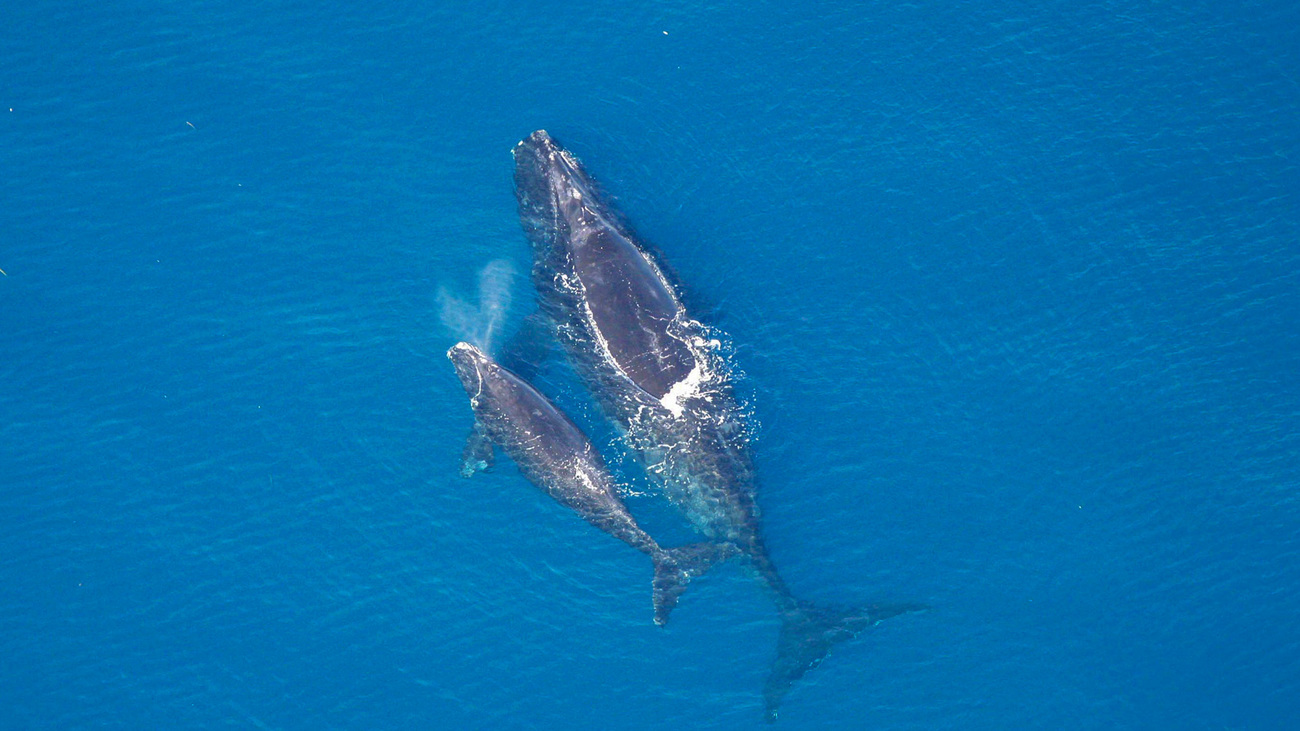Saving the North Atlantic right whale - North America
Don't fail our whaleNorth Atlantic right whale 2025 calving season: report card
North Atlantic right whale 2025 calving season: report card
Every year, North Atlantic right whale mothers face tremendous challenges to raising healthy calves. Even after giving birth in the warm waters off the coast of the Southeast US, the mother–calf pairs have to make a long and harrowing journey north to their foraging grounds off New England and Canada.
This year’s calving season (mid-November 2024 to mid-April 2025) was no different.
Here is our report of the highs, lows, and room for improvement as the 2025 calving season draws to a close.
Overall outlook in numbers
With only about 370 individuals remaining, the North Atlantic right whale is critically endangered. Since 2017, the species has been suffering an unusual mortality event, which has seen the deaths of 41 individuals, in addition to 39 serious and 77 sublethal injuries. They’re also reproducing more slowly than they used to. Instead of having calves every three years, the average female now has a calf every six to ten years. This is likely due to stress from entanglements, navigation amongst busy maritime traffic, increasing ocean noise, and the changing distribution of their food sources, which is affected by the climate.
The species’ high mortality rate combined with the low birth rate means the number of new calves each season is more important than ever. For their population to recover and grow, 50 newborns are needed each season, but a season will be considered ‘productive’ if it brings at least 20 new calves.
In the 2025 season, only 10 new identified calves, and one unidentified, were spotted. While there’s a small chance we’d see new calves at the end of April, it’s likely that this is the final tally for the year.
Last year, 20 new calves were born, but five died or are presumed to be dead.
We are very far from reaching a stable North Atlantic right whale population. But despite the very real threats facing this critically endangered species, we are confident that it can recover through unwavering conservation efforts and some simple but effective actions from the public.
The first sighting
The first calf of the season was spotted not by researchers or innovative technology but by a member of the public who was boating off Cape Romain, South Carolina, on 24 November 2024. Fortunately, the boater knew what to do, immediately reporting the sighting to proper authorities. IFAW has helped develop an app to make this easy: it’s called Whale Alert.
Photos of the mother–calf pair weren’t clear enough for researchers to identify the mother, but three potential mothers had been seen in the area between 20 and 25 November: Black Heart (Catalog #3540), Koala (Catalog #3940), and Curlew (Catalog #4190).
Blackheart has since been sighted with her calf, but we hope to gather enough information to determine if this unidentified pair was Koala or Curlew.
Reported sightings like these are vital for keeping right whales safe from a collision course with other boats and ships. With support like this individual demonstrated, together we can help save this species.
An unusual sighting
On 3 February 2025, Accordion (Catalog #4150) was seen with her first known calf—a reason to celebrate! We are especially happy for her first birth because Accordion herself has survived a traumatic injury, being named for the accordion-shaped scar on her back from a vessel propeller.
However, Accordion and her calf were spotted close to the shipping lanes at the entrance to the Port Authority of New York and New Jersey. It’s unusual to see such young calves that far north at that time of year, because most are born in the warmer waters around South Carolina, Georgia, and Florida.
Their proximity to such busy shipping lanes is worrisome. Fortunately, they were seen within a Seasonal Management Area, where vessels 65 feet or longer must travel at 10 knots or less—but these whales are also very vulnerable to strikes from smaller vessels, like recreational and fishing boats, too.
We don’t know for sure why Accordion and her calf were swimming there, but there are a few possibilities. Accordion has never been seen in the Southeast calving grounds, and this is her first known calf, so she might simply be behaving in an atypical, individual way and setting her own migration patterns. Warmer ocean temperatures might also be changing where food is most abundant at that time of year or where females feel most comfortable giving birth. As right whale distribution is altered by climate change, marine authorities will need to adjust the regulations that protect these whales.

Conservation challenges
The biggest threats these whales face are vessel strikes and entanglement in fishing gear.
Even when a whale isn’t immediately killed by a collision with a vessel or being weighed down with ropes, they become weakened—less capable of swimming the distances necessary to find enough food, not strong enough to reproduce, and less resilient to other stressors in their environment.
During this calving season, two whales were spotted entangled in ropes off the coast of Massachusetts. On 9 December 2024, a NOAA Fisheries aerial survey found a young male (#5110) of around three years old who was so severely entangled that NOAA Fisheries biologists considered it a serious injury, meaning he is unlikely to survive. He has not been seen since.
The same day, an adult female (Catalog #4120) was seen with ropes trailing from her mouth. Her entanglement was determined to be causing sublethal injuries and was considered a morbidity case. Fortunately, on 9 February 2025, she was seen swimming in Cape Cod Bay and seemed to be free of the gear. Despite being of reproductive age, this whale has never had a calf of her own. Sublethal injuries such as what she experienced may be playing a part in that.
With fewer than 70 reproductive-age females remaining, every single one is vital to the species’ survival, and they need to be healthy and strong to survive birthing a calf and be able to nurse it.
Technological advancements
Technology is one of our key resources in the fight to save North Atlantic right whales. We’re working with partners to develop innovative monitoring solutions and methods to protect them.
For example, we’re finding new ways to use technology that many mariners already use—Automatic Identification Systems (AIS).
This is crucial navigation technology that provides other mariners and maritime authorities on the shore with real-time information about the position, course, and speed of vessels. All commercial vessels 65 feet and longer are required to carry an AIS collision avoidance system, but many other vessels carry it voluntarily. IFAW’s collaborative project uses AIS to send alerts to ships in areas with recent whale sightings and in zones with speed limits.
In Canada, IFAW and our partners are supporting the use of Smart Buoy technology, which can notify fishers quickly in the event of entanglement, gear movement and loss due to storms, or buoys being cut loose by other vessels. We aim to work with snow crab harvesters, First Nations communities, mariners, and the broader public to raise awareness and adopt such practical solutions while supporting local industry.
We’re also supporting fishermen in adopting on-demand fishing gear, also known as ropeless gear, during fisheries closures. On-demand gear only deploys lines to attach to undersea gear (such as lobster traps) when the fishing vessel is on scene and ready to retrieve it. Reducing the presence of vertical buoy lines in the water significantly reduces the threat of entanglement while also ensuring fishermen can continue their work.
Community involvement
The public plays a key role in saving these whales. The first calf of the season was spotted by a boater, who then alerted authorities. Quick, simple actions like this one help researchers and conservationists protect the species by informing other mariners nearby to reduce speeds and use caution.
It’s crucial for everyone who spends time on the water to report any right whale sightings to 1-877-WHALE-HELP or to the US Coast Guard on VHF Channel 16. You can also download IFAW’s Whale Alert app to be aware of whales in your area and report sightings.

You can make the difference between life and death for these vulnerable calves and mothers.
Importance of education
Understanding these whales helps us predict where they will be, what threatens their survival, and how we can minimise those threats.
Researchers track these whales very closely, keeping a list called the North Atlantic Right Whale Catalog with each whale they’ve identified, when and where it was spotted, and whether it shows signs of illness, entanglement, trauma, or poor health. They can identify individual whales because their callosities—rough, white patches on their heads—are as unique as humans’ fingerprints. They often also have scars or other distinguishing marks.
Several features make North Atlantic right whales identifiable as a species. Like other baleen whales, they have two nares (commonly called blowholes), while toothed whales have one. When North Atlantic right whales exhale from their nares, the water vapor (blow) forms a distinctive V shape, while many other species produce a more vertical blow. Right whales are darker in colour than many other whales, lack dorsal fins, and are the only whales that have callosities.

One of the best ways to support conservation efforts is to talk with family and friends about why these animals are so important, because that helps increase support for conservation programmes and legislation. Sharing interesting facts is a great way to start those conversations—for example, did you know that whale poo helps fight climate change?
Another great way to start these conversations is by sporting IFAW’s new North Atlantic right whale merchandise, showing your passion for conservation while supporting our work.
Looking ahead to the coming year
Every calf that survives these critical early months of their lives inspires hope. Each one deserves our tireless efforts to protect their species. With the right monitoring, safety protocols, legislation, and efforts from everyone who spends time on the ocean, we can rewrite the future for these critically endangered whales.
When these young whales are old enough to have calves of their own, we want them to be born into a thriving, healthy ocean.
Help us save North Atlantic right whales from extinction.
Related content
every problem has a solution, every solution needs support.
The problems we face are urgent, complicated, and resistant to change. Real solutions demand creativity, hard work, and involvement from people like you.